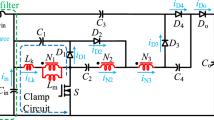Abstract
To increase the voltage gain of power electronic circuits, numerous converters have been designed by researchers. In particular, step-up converters are used in various circuits and systems due to their reliability. Mostly, in some studies, researchers proposed to use coupled inductors and switched capacitors. Therefore, in this study, we aim to use new-generation E-HEMT switches by using a hybrid topology which includes both a switched capacitor and a coupled inductor to deliver ultra-high voltage to the output. The proposed switched capacitor-based hybrid converter (SCBHC) is modeled in Simulink and PowerSim to verify the analytical voltage gain derivations. The proposed SCBHC is compared with a traditional boost converter, a switched capacitor-based topology and two different coupled inductor-based schemes in terms of gain performance for different duty cycles, switching frequencies and turn ratios. With this combined design, we obtain approximately 300–400% more voltage gain than a traditional boost converter. The proposed SCBHC provides a considerable gain and a wide output voltage range with lower turn ratios compared with other topologies.










Similar content being viewed by others
References
Tofoli, F.L.; Pereira, D.C.; Paula, W.J.; Oliviera Junior, D.S.: Survey on non-isolated high-voltage step-up dc-dc topologies based on the boost converter. IET Power Electron. 8(10), 2044–2057 (2015)
Li, W.; He, X.: Review of nonisolated high-step-up dc/dc converters in photovoltaic grid-connected applications. IEEE Trans. Ind. Electron. 58(4), 1239–1250 (2011)
Alexrod, B.; Berkovich, Y.; Ioinovici, A.: A cascade boost-capacitor-switched-converter two level inverter with an optimized multilevel output waveform. IEEE Trans. Circuits Syst. 52(12), 2763–2770 (2005)
Abutbul, O.; Gherlitz, A.; Berkovich, Y.; Ioinovici, A.: Step-up switching-mode converter with high voltage gain using a switched capacitor circuit. IEEE Trans. Circuits Syst. 50(8), 1098–1102 (2003)
Alexrod, B.; Berkovich, Y.; Ioinovici, A.: Transformerless dc-dc converters with a very high dc line-to-load voltage ratio. In: Proceedings of the International Symposium on Circuits and Systems, pp. III-433-III-438 (2003)
Li, K.; Hu, Y.; Ioinovici, A.: Generation of the large dc gain step-up non-isolated converters in conjunction with renewable energy sources starting from a proposed geometric structure. IEEE Trans. Power Electron. 32(7), 5323–5340 (2017)
Chen, M.; Li, K.; Hu, J.; Ioinovici, A.: Generation of a family of very high dc gain power electronics circuits based on switched-capacitor-inductor cells starting from a simple graph. IEEE Trans. Circuits Syst. 63(12), 2381–2392 (2016)
Cheung, C.; Tan, S.; Tse, C.K.; Ioinovici, A.: On energy efficiency of switched-capacitor converters. IEEE Trans. Power Electron. 28, 2 (2013)
Liang, T.; Chen, S.; Yang, L.; Chen, J.; Ioinovici, A.: Ultra-large gain step-up switched-capacitor dc-dc converter with coupled inductor for alternative sources of energy. IEEE Trans. Circuits Syst. 59(4), 864–874 (2012)
Tan, S.; et al.: Variable structure modeling and design of switched-capacitor converters. IEEE Trans. Circuits Syst. 56(9), 2132–2142 (2009)
Tseng, K.; Liang, T.: Novel high efficiency step-up converter. IEE Proc. Electr. Power Appl. 151(2), 182–190 (2004)
Liang, T.; Tseng, K.: Analysis of integrated boost-flyback step-up converter. IEE Proc. Electr. Power Appl. 152(2), 217–225 (2005)
Hsieh, Y.; Chen, J.; Liang, T.; Yang, L.: A novel high step-up dc-dc converter for a microgrid system. IEEE Trans. Power Electron. 26(4), 1127–1136 (2011)
Hsieh, Y.; Chen, J.; Liang, T.; Yang, L.: Analysis and implementation of a novel single-switch high step-up dc–dc converter. IET Power Electron. 5(1), 11–21 (2010)
Hsieh, Y.; Chen, J.; Liang, T.; Yang, L.: Novel high step-up dc-dc converter for distributed generation system. IEEE Trans. Indu. Electron. 60(4), 1473–1482 (2013)
Chen, S.; Lao, M.; Hsieh, Y.; Liang, T.; Chen, K.: A novel switched-coupled-inductor dc-dc step-up converter and its derivatives. IEEE Trans. Ind. Appl. 51(1), 309–314 (2015)
Liang, T.; Lee, J.: Novel high-conversion-ratio high-efficiency isolated bidirectional dc-dc converter. IEEE Trans. Ind. Electron. 62(7), 4492–4503 (2015)
Hwu, K.; Jiang, W.: A KY converter integrated with a SR boost converter and coupled inductor. J. Power Electron. 17(3), 621–631 (2017)
GaN Systems: Top-side cooled 100 V E-mode GaN transistor. GS61008T, Datasheet (2017 July)
GaN Systems: Bottom-side cooled 650 V E-mode GaN transistor. GS66516B, Datasheet (2017 July)
Author information
Authors and Affiliations
Corresponding author
Rights and permissions
About this article
Cite this article
Cengiz, K. Very High Step-Up Converter with Switched Capacitor and Coupled Inductor. Arab J Sci Eng 45, 1777–1783 (2020). https://doi.org/10.1007/s13369-019-04276-w
Received:
Accepted:
Published:
Issue Date:
DOI: https://doi.org/10.1007/s13369-019-04276-w




